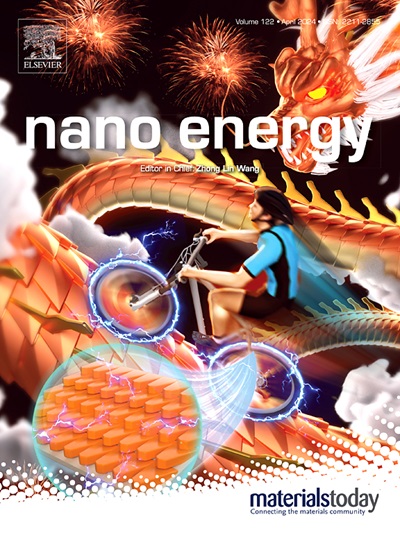Visible droplet luminescence in daylight
IF 17.1
1区 材料科学
Q1 CHEMISTRY, PHYSICAL
引用次数: 0
Abstract
Droplet luminescence (DL), which is based on the coupling of contact electrification and electroluminescence, has great potential in various fields owing to its unique motion-driven optical response. However, the current DL method is limited by its weak intensity, complex structure, and laborious techniques. In this study, intense DL, visible even in daylight, was realized using a facile method. An exact multi-physics simulation confirmed that DL could be directly excited by the interfacial electric field in liquid-solid contact without any pretreatment. A relevant strategy of semi-embedding luminescent particles in ultra-thin polymer film was proposed to ensure sufficient liquid-solid contact to transfer the interfacial charge and maximize the direct excitation of luminescent particles by the interfacial electric field. This bright DL demonstrates considerable potential for practical applications in sensors, display, and information storage. More importantly, this DL throws a light onto the liquid-solid interface for visualizing the dynamic process of charge transfer throughout the liquid-solid contact, which may provide insights for the exploration of interfacial charge transfer.
日光中可见的微滴发光
液滴发光(DL)是一种基于接触电致发光和电致发光耦合的发光技术,由于其独特的运动驱动光学响应,在各个领域都有很大的应用潜力。然而,目前的深度学习方法存在强度弱、结构复杂、技术费力等缺点。在这项研究中,使用一种简单的方法实现了即使在白天也能看到的强烈DL。一个精确的多物理场模拟证实,在液固接触中,DL可以直接被界面电场激发,而无需任何预处理。提出了一种在超薄聚合物薄膜中半嵌入发光粒子的策略,以保证充分的液固接触来传递界面电荷,并最大限度地利用界面电场对发光粒子的直接激发。这种明亮的DL在传感器、显示和信息存储方面显示出相当大的实际应用潜力。更重要的是,这一DL揭示了液固界面的电荷传递动态过程,为探索界面电荷传递提供了新的思路。
本文章由计算机程序翻译,如有差异,请以英文原文为准。
求助全文
约1分钟内获得全文
求助全文
来源期刊

Nano Energy
CHEMISTRY, PHYSICAL-NANOSCIENCE & NANOTECHNOLOGY
CiteScore
30.30
自引率
7.40%
发文量
1207
审稿时长
23 days
期刊介绍:
Nano Energy is a multidisciplinary, rapid-publication forum of original peer-reviewed contributions on the science and engineering of nanomaterials and nanodevices used in all forms of energy harvesting, conversion, storage, utilization and policy. Through its mixture of articles, reviews, communications, research news, and information on key developments, Nano Energy provides a comprehensive coverage of this exciting and dynamic field which joins nanoscience and nanotechnology with energy science. The journal is relevant to all those who are interested in nanomaterials solutions to the energy problem.
Nano Energy publishes original experimental and theoretical research on all aspects of energy-related research which utilizes nanomaterials and nanotechnology. Manuscripts of four types are considered: review articles which inform readers of the latest research and advances in energy science; rapid communications which feature exciting research breakthroughs in the field; full-length articles which report comprehensive research developments; and news and opinions which comment on topical issues or express views on the developments in related fields.
 求助内容:
求助内容: 应助结果提醒方式:
应助结果提醒方式:


